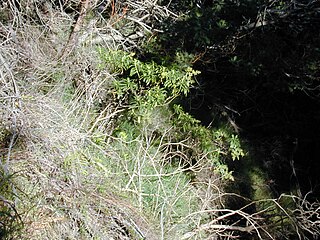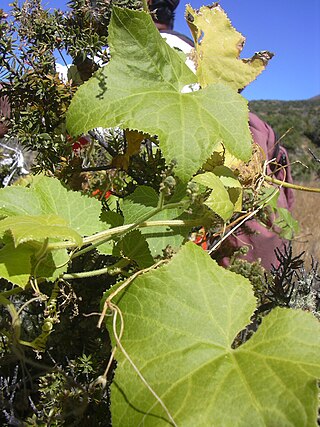Hawaiian hibiscus are seven species of hibiscus native to Hawaii. The yellow hibiscus is Hawaii's state flower. Most commonly grown as ornamental plants in the Hawaiian Islands are the non-native Chinese hibiscus and its numerous hybrids, though the native Hibiscus arnottianus is occasionally planted.

Adenophorus periens is a rare species of fern known by the common name pendant kihi fern. It is endemic to Hawaii, where it is known from one population in Puna on the island of Hawaii and a few occurrences on Kauai and Molokai. The fern occurs in wet mountain forests on volcanic slopes. It grows on trees. There are perhaps 2000 individual plants remaining. This is a federally listed endangered species of the United States.
Cyanea mceldowneyi is a rare species of flowering plant in the bellflower family known by the common name McEldowney cyanea. It is endemic to Hawaii, where it is known only from the island of Maui. A 2007 count estimated 60 plants remaining in two populations. It was federally listed as an endangered species of the United States in 1992. Like other Cyanea it is known as haha in Hawaiian.

Cyperus trachysanthos is a rare species of sedge known by the common names pu`uka`a and sticky flatsedge. It is endemic to Hawaii, where it is known from Kauai and Oahu. It was known from Niihau, Molokai and Lanai, but it has been extirpated from these islands. It is a federally listed endangered species of the United States.

Dubautia plantaginea is a rare species of flowering plant in the aster family known by the common name plantainleaf dubautia. It is endemic to Hawaii where it is the only member of the silversword alliance that is found on all six of the largest islands. Two of the three subspecies are rare and endangered. Like other Dubautia this plant is called na`ena`e.

Kadua coriacea is a rare species of flowering plant in the coffee family known by the common name kioʻele. It is endemic to Hawaii, where it is known only from the island of Hawaiʻi and one individual remaining on Maui. It is a federally listed endangered species of the United States.

Ischaemum byrone, commonly known as Hilo murainagrass or Hilo ischaemum, is a rare and endemic species of grass native to Hawaii. It is found on the islands of Kauai, Maui, Molokai, and Hawaii but has unfortunately been extirpated from Oahu, where it was once known to grow. There are perhaps 1000 to 3000 individual plants remaining in total. This is a federally listed endangered species of the United States.
Cyperus fauriei is a rare species of sedge known by the common name alpine flatsedge. It is endemic to Hawaii, where it grows on the islands of Molokai and Hawaii. It is a federally listed endangered species of the United States.

Cyperus pennatiformis is a rare species of sedge known by the common name coastal flatsedge. It is endemic to Hawaii, where it grows on the islands of Maui, Kauai, and Laysan. It is a federally listed endangered species of the United States.
Melicope munroi is a rare species of flowering plant in the family Rutaceae known by the common names lanahale and Munro's pelea. It is endemic to Hawaii, where it is known only from the island of Lanai. It is a federally listed endangered species of the United States. Like other Hawaiian Melicope, this species is known as alani.

Peucedanum sandwicense is a rare species of flowering plant in the carrot family known by the common name makou. It is endemic to Hawaii, where it is known from Maui, Molokai, Kauai, and Oahu. It is threatened by introduced species of plants and animals. It is a federally listed threatened species of the United States.

Plantago princeps is a rare species of flowering plant in the plantain family known by the common name ale. It is endemic to Hawaii, where it is known from the islands of Hawaii, Kauai, Oahu, Molokai, and Maui. Like other Hawaiian Plantago, it is known as kuahiwi laukahi, or laukahi kuahiwi. It is a federally listed endangered species of the United States.
Peristylus holochila is a rare species of orchid known by the common name Hawaii bog orchid. It is endemic to Hawaii. It is a federally listed endangered species of the United States.

Schiedea haleakalensis is a rare species of flowering plant in the family Caryophyllaceae known by the common name Haleakalā schiedea. It is endemic to Hawaii, where it is known only from Haleakalā National Park on the island of Maui. It is threatened by the degradation of its habitat. It was federally listed as an endangered species of the United States in 1992. Its native habitat includes dry subalpine cliffs with native shrubs.
Schiedea membranacea is a rare species of flowering plant in the family Caryophyllaceae known by the common name valley schiedea. It is endemic to Hawaii, where it is known only from the island of Oahu. It has been extirpated from Maui and Molokai. Plants in a population known from Kauai are actually members of other species. Thus, the species is now endemic to Oahu. It is threatened by the degradation and destruction of its habitat. It is a federally listed endangered species of the United States.
Schiedea sarmentosa is a rare species of flowering plant in the family Caryophyllaceae known by the common name cliff schiedea. It is endemic to Hawaii, where it is known only from the island of Molokai. It is threatened by the degradation and destruction of its habitat. It is a federally listed endangered species of the United States.

Silene lanceolata is a rare species of flowering plant in the family Caryophyllaceae known by the common names Kauai catchfly and lanceolate catchfly. It is endemic to Hawaii, where it is known only from Oahu, Molokai, and Hawaii, having been extirpated from Kauai and Lanai. It is threatened by the degradation of its habitat and it is a federally listed endangered species of the United States.

Spermolepis hawaiiensis is a rare species of flowering plant in the carrot family known by the common name Hawai'i scaleseed. It is endemic to Hawaii, where it is known from the islands of Kauai, Maui, Oahu, Molokai, Lanai, and Hawaii. It is threatened by the degradation of its habitat and it is a federally listed endangered species.

Sicyos macrophyllus is a rare species of flowering plant in the Cucurbitaceae, the squash family. It is endemic to Hawaii where it is present only on the island of Hawaii. It has likely been extirpated from the island of Maui. Common names include alpine bur cucumber, largeleaf bur-cucumber, and 'anunu.

Phyllostegia haliakalae, commonly known as the Haliakala phyllostegia, is a species of flowering plant in the mint family, Lamiaceae. It was described by Heinrich Wawra von Fernsee in 1872. The species Latin name derives from the Hawaiian word, "haliakala", which means "happy".














